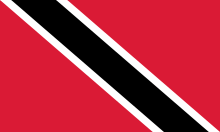TRINIDAD & TOBAGO
 Trinidad’s area is 4 821 sq km, Tobago represents 303 sq km. Trinidad is the largest island of the Eastern Caribbean. Only 11km separate it from Venezuela. In the north of the territory, a range of mountains is covered with tropical forest ; the Northern Range crosses Trinidad from east to west. In the centre, towers up Cerro del Oripo, the highest summit of the island which is 941m. Plains and hills occupy the rest of the island.
Trinidad’s area is 4 821 sq km, Tobago represents 303 sq km. Trinidad is the largest island of the Eastern Caribbean. Only 11km separate it from Venezuela. In the north of the territory, a range of mountains is covered with tropical forest ; the Northern Range crosses Trinidad from east to west. In the centre, towers up Cerro del Oripo, the highest summit of the island which is 941m. Plains and hills occupy the rest of the island.
Located in 20 km in the north-east of Trinidad, Tobago has also a range of green mountains whose highest point is 620m and large valleys.
Because both islands are near to South America, the wildlife and the flora are very rich. For example, there are 400 species of bird (parrots, frigates, pelicans, birds of paradise…), 100 species of mammal (armadillos, howler monkeys, anteaters…), 50 species of reptile, 700 species of orchid, 1600 species of flowering plant etc.
Trinidad and Tobago are situated off the hurricanes path, a natural phenomenon that threatens the Caribbean from June to November.
Trinidad has oil, natural gas, asphalt, caol, iron ore. Food processing, steel, electronics constitute the industrial sector. Sugar, rice, cocoa, coffee and citrus fruits are the main agricultural productions.
The seafarer, Christopher Columbus, discovered Trinidad in 1498 and named it “La Isla de la Trinidad” (The Island of the Holy Trinity). The Carib Indians called it “Lere” (Land of Hummingbirds). The Spanish were not interested in this island because it did not have deposits of gold. They settled there a colony in 1592 – San Josef – located in the east of the present capital, Port of Spain. The Europeans planted cocoa and tabacco but they did not become wealthy. Spain was afraid that England seized Trinidad so, in 1783, it proclaimed a “cedula” in order to encourage Catholic colonists to settle in Trinidad in exchange for lands and premiums. The new inhabitants came mainly from the French colonies with their African slaves to develop sugar cane plantations.
In 1797, the British appropriated the island. In 1807, they forbade the slaves trade then, in 1834, slavery was abolished.
Tobago was also discovered by Columbus but the Spanish did not colonize it. In 1628, Charles I of England gave the island to the Count of Pembroke. The rivalries started between English, French, Dutch and even Latvian people. Several battles destroyed completely the villages and several times, Tobago changed owner.
In 1704, Tobago became a neutral territory so, pirates began to transform it into a base to attack ships cruising in the Caribbean Sea. In 1763, the signature of the Treaty of Paris gave officially Tobago to the British. Next years, thousands of African slaves were imported to the island in order to grow sugar cane, cotton, indigo etc. The French appropriated several times the island until the beginning of the 19th century.
In both islands, the Abolition of slavery in 1834 caused little by little the decline of the plantations.
In 1889, Tobago did not have any more representatives so, England place the island under the supervision of Trinidad.
Trinidad and Tobago became independent on August 31,1962. The country is a presidential republic but the political power is held by the Prime Minister. Tobago has its own assembly. The country belongs to the Commonwealth.
Area : Trinidad : 4 821 sq km (1 861 sq miles) / Tobago : 303 sq km (116 sq miles)
Population : 1,3 million inhabitants
Capital : Port of Spain
Language : English (official)
Currency : Trinidad and Tobago Dollar (TT$)
People : Trinidadians / Tobagonians
